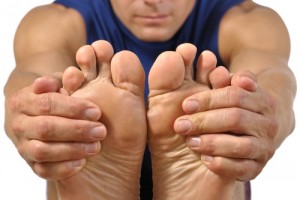What is Plantar Fasciitis ?
“Every time I get out of bed in the morning the bottom of my foot hurts near the heel. It feels like a knife is being jabbed into the bottom of my foot. After I walk 5-10 steps it starts to feel a little better. It almost feels like the plantar fascia limbers up. I also notice if I sit for a long period of time and then stand up I have similar symptoms. As the day progresses and I am up on my feet more and more the pain returns.” This person is describing symptoms consistent with plantar fasciitis.
 “What is plantar fasciitis, and more importantly how do I get rid of it?” This is a very common question I get asked on a daily basis.
“What is plantar fasciitis, and more importantly how do I get rid of it?” This is a very common question I get asked on a daily basis.
Plantar fasciitis is the most common cause of heel pain. The plantar fascia, located on the bottom of your foot, originates at the calcaneous (the heel bone) and attaches to the bottom portions of your toes.
The plantar fascia is a thick band of tissue and it helps to support the arch of the foot.
When the plantar fascia gets inflamed it becomes very painful. There are small micro tears that can occur in the ligament. It can hurt with every step. It is difficult to walk without putting force or pressure on your plantar fascia. When it gets inflamed it is called plantar fasciitis.
Plantar Fasciitis Treatment
Plantar fasciitis treatment is typically non-surgical. First and foremost, if you are struggling with plantar fasciitis, it is very important to see a physical therapist. The physical therapist will teach you a series of stretches that will help you get rid of the condition. The physical therapist may do some ultrasound and deep tissue mobilization to help reduce and get rid of the inflammation. Physical therapy is the first-line of treatment for plantar fasciitis.
If you’re suffering from plantar fasciitis, shoe wear is also critical. Getting into a shoe that has built in arch support is very important. The arch support will take the force off of the inflamed plantar fascia.
The third part of the treatment involves the use of an anti-inflammatory medication. The anti-inflammatory medication can help intrinsically reduce the inflammation within the plantar fascia.
A night splint, which is a gadget that can be worn on the foot and lower part of the leg, can also help to cure planter fasciitis. The night splint keeps the foot in a neutral position at night. That will prevent the plantar fascia from shortening over the course of night while sleeping and allow the inflammation to resolve quicker.
As an orthopedic surgeon and sports medicine physician, I always recommend to my patients that they do not walk barefoot. When walking without shoes it leaves the inflamed plantar fascia unsupported and puts continuous stress on the painful area.
Plantar facilities can be difficult to cure. If the above treatment fails, a cortisone injection can help. Cortisone can be thought of as a highly concentrated Motrin or anti-inflammatory medication that is put directly into the area of inflammation as opposed to taking a medication by mouth and having it disseminate all of the body and eventually make its way to the area of plantar fasciitis.
Newer Plantar Fasciitis Treatment Options
Newer treatment options for plantar fasciitis include the injection of PRP into the area to target inflammation. PRP is also known as platelet rich plasma.
PRP is being used to treat other areas of inflammation in the body. The three most common areas that PRP is being used are:
- Lateral epicondylitis (in the elbow, also known as “tennis elbow”)
- Achilles tendinitis
- Patellar Tendinitis.
PRP is made by taking blood peripherally from the patient and placing it into a centrifuge. Different components of the whole blood such as the platelets, red cells, and stem cells with growth factors are separated. The cells that can reduce inflammation and have healing potential are then injected into the area of the plantar fascia.
If you are suffering from plantar fasciitis and need medical treatment, call 502-212-2663 to make an appointment with board certified orthopedic surgeon and sports medicine physician Dr. Stacie Grossfeld at Orthopaedic Specialists.

Recent Comments